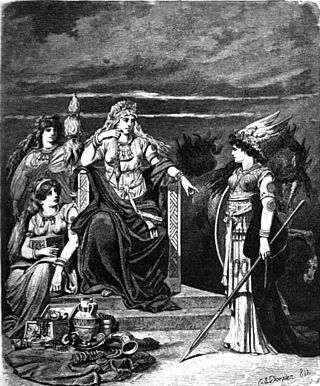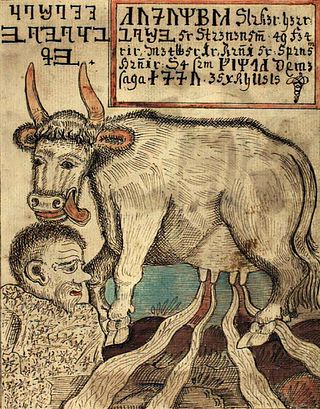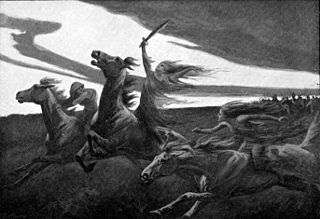Related Research Articles

In Nordic mythology, Asgard (Old Norse: Ásgarðr

In Norse mythology, Hlín is a goddess associated with the goddess Frigg. Hlín appears in a poem in the Poetic Edda, compiled in the 13th century from earlier traditional sources, the Prose Edda, written in the 13th century by Snorri Sturluson, and in kennings found in skaldic poetry. Scholars have debated whether the stanza referring to her in the Prose Edda refers to Frigg. Hlín serves as a given name in Iceland, and Hlín receives veneration in the modern era in Germanic paganism's modern extension, Heathenry.

In Norse mythology, Snotra is a goddess associated with wisdom. Snotra is attested in the Prose Edda, written in the 13th century by Snorri Sturluson, and in the Gautreks Saga, where she is the mother of Gautrek son of Gauti, the eponymous ancestor of the Geats, and Goths, a son of Oðinn as King of Sviþjoð. Scholars have proposed theories about the implications of the goddess.
In Norse mythology, Vör is a goddess associated with wisdom. Vör is attested in the Prose Edda, written in the 13th century by Snorri Sturluson; and twice in kennings employed in skaldic poetry. Scholars have proposed theories about the implications of the goddess.

In Norse mythology, Níðhöggr is a dragon who gnaws at a root of the world tree, Yggdrasil. In historical Viking society, níð was a term for a social stigma, implying the loss of honor and the status of a villain. Thus, its name might refer to its role as a horrific monster in its action of chewing the corpses of the inhabitants of Náströnd: those guilty of murder, adultery, and oath-breaking.

In Norse mythology, Búri, is a divinity god 'producer, father' of all other gods, and an early ancestor of the Æsir gods of the principal pantheon in Norse religion. Búri was licked free from salty rime stones by the primeval cow Auðumbla over the course of three days. Búri's background beyond this point is unattested, and he had a son, Borr, by way of an unknown process. Búri is attested in the Prose Edda, composed in the 13th century by Icelander Snorri Sturluson. The Prose Edda includes a quote from a 12th-century poem by skald Þórvaldr Blönduskáld that mentions the figure. Búri's mysterious origins are the subject of scholarly commentary and interpretation.
In Norse mythology, Sessrúmnir is both the goddess Freyja's hall located in Fólkvangr, a field where Freyja receives half of those who die in battle, and also the name of a ship. Both the hall and the ship are attested in the Prose Edda, written in the 13th century by Snorri Sturluson. Scholarly theories have been proposed regarding a potential relation between the hall and the ship.

In Norse mythology, a dís is a female deity, ghost, or spirit associated with Fate who can be either benevolent or antagonistic toward mortals. Dísir may act as protective spirits of Norse clans. It is possible that their original function was that of fertility goddesses who were the object of both private and official worship called dísablót, and their veneration may derive from the worship of the spirits of the dead. The dísir, like the valkyries, norns, and vættir, are always referred collectively in surviving references. The North Germanic dísir and West Germanic Idisi are believed by some scholars to be related due to linguistic and mythological similarities, but the direct evidence of Anglo-Saxon and Continental German mythology is limited. The dísir play roles in Norse texts that resemble those of fylgjur, valkyries, and norns, so that some have suggested that dísir is a broad term including the other beings.
In Norse cosmology, svartálfar, also called myrkálfar, are beings who dwell in Svartálfheim. Both the svartálfar and Svartálfaheimr are primarily attested in the Prose Edda, written in the 13th century by Snorri Sturluson. Scholars have noted that the svartálfar appear to be synonymous with the dwarfs and potentially also the dökkálfar. As dwarfs, the home of the svartálfar could possibly be another description for Niðavellir.
In Norse mythology, Borr or Burr was the son of Búri. Borr was the husband of Bestla and the father of Odin, Vili and Vé. Borr receives mention in a poem in the Poetic Edda, compiled in the 13th century from earlier traditional material, and in the Prose Edda, composed in the 13th century by Icelander Snorri Sturluson. Scholars have proposed a variety of theories about the figure.
Narfi, also Nörfi, Nari or Nörr, is a jötunn in Norse mythology, and the father of Nótt, the personified night.

Lóðurr is a god in Norse mythology. In the Poetic Edda poem Völuspá, he is assigned a role in animating the first humans, but apart from that he is hardly ever mentioned, and remains obscure. Scholars have variously identified him with Loki, Vé, Vili, and Freyr, but consensus has not been reached on any one theory.
In Norse mythology, Auðr is the son of the personified night, Nótt, fathered by Naglfari, and uncle of Thor. Auðr is attested in the Prose Edda, written in the 13th century by Snorri Sturluson, and in the poetry of skalds.

Eikþyrnir or Eikthyrnir, is a stag which stands upon Valhalla in Norse mythology. The following is related in the Gylfaginning section of Snorri Sturluson's Prose Edda after the description of Heiðrún.
In Norse mythology, Þrúðvangr or Þrúðvangar is/are a field/fields where the god Thor resides. The field is attested in the Prose Edda and in Heimskringla, both written by Snorri Sturluson in the 13th century.

In Norse mythology, Himinbjörg is the home of the god Heimdallr. Himinbjörg is attested in the Poetic Edda, compiled from earlier traditional sources, and the Prose Edda and Heimskringla, both written in the 13th century by Snorri Sturluson. Himinbjörg is associated with Heimdallr in all sources. According to the Poetic Edda, Heimdallr dwells there as watchman for the gods and there drinks fine mead, whereas in the Prose Edda Himinbjörg is detailed as located where the burning rainbow bridge Bifröst meets heaven. Scholars have commented on the differences between the two attestations and linked the name of the mythical location to various place names.
In Norse mythology, Sindri is the name of both a dwarf and a hall that will serve as a dwelling place for the souls of the virtuous after the events of Ragnarök. Sindri is also referred to as Eitri, the brother of Brokkr.
In Norse mythology, Ámsvartnir is a lake containing the island Lyngvi, where the gods bound the wolf Fenrir. The lake is only referenced in the Prose Edda, book Gylfaginning, written in the 13th century by Snorri Sturluson. In the book, the enthroned figure of High tells Gangleri that the gods and Fenrir fared across Amsvartnir to get to Lyngvi, and there bound Fenrir.

In Norse mythology, Sága is a goddess associated with the location Sökkvabekkr. At Sökkvabekkr, Sága and the god Odin merrily drink as cool waves flow. Both Sága and Sökkvabekkr are attested in the Poetic Edda, compiled in the 13th century from earlier traditional sources, and in the Prose Edda, written in the 13th century by Snorri Sturluson. Scholars have proposed theories about the implications of the goddess and her associated location, including that the location may be connected to the goddess Frigg's fen residence Fensalir and that Sága may be another name for Frigg.
In Norse mythology, Narfi is a son of Loki, referred to in a number of sources. According to the Gylfaginning section of Snorri Sturluson's Prose Edda, he was also called Nari and was killed by his brother Váli, who was transformed into a wolf; in a prose passage at the end of the Eddic poem "Lokasenna", Narfi became a wolf and his brother Nari was killed.
References
- Ásgeir Blöndal Magnússon (1989). Íslensk orðsifjabók. Reykjavík: Orðabók Háskólans.
- Brodeur, Arthur Gilchrist (transl.) (1916). The Prose Edda by Snorri Sturluson. New York: The American-Scandinavian Foundation. Available online
- Eysteinn Björnsson (ed.). Snorra-Edda: Formáli & Gylfaginning : Textar fjögurra meginhandrita. 2005. http://www.hi.is/~eybjorn/gg/
- Eysteinn Björnsson (ed. & tr.) (2002). Hrafnagaldur Óðins : Forspjallsljóð. http://www.hi.is/~eybjorn/ugm/hrg/hrg.html
- Jónsson, Finnur (1931). Lexicon Poeticum. København: S. L. Møllers Bogtrykkeri.
- Simek, Rudolf. Dictionary of Northern Mythology. 1993. Trans. Angela Hall. Cambridge: D. S. Brewer. ISBN 0-85991-369-4. New edition 2000, ISBN 0-85991-513-1.
- Thorpe, Benjamin (tr.) (1866). Edda Sæmundar Hinns Froða : The Edda Of Sæmund The Learned. (2 vols.) London: Trübner & Co. Available online